Grenadier
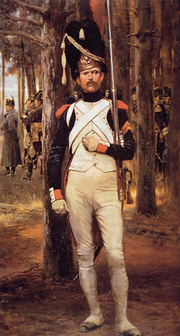
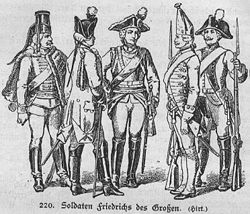
A grenadier (derived from the word grenade) was originally a specialized soldier, first established as a distinct role in the mid to late 17th century, for the throwing of grenades and sometimes assault operations. At this time grenadiers were chosen from the strongest and largest soldiers. By the nineteenth century, the throwing of grenades was no longer relevant, but grenadiers were still chosen for being the most physically powerful soldiers and would lead assaults in the field of battle. Grenadiers would also often lead the storming of breaches in siege warfare, although this role was more usually fulfilled by all-arm units of volunteers called forlorn hopes, and might also be fulfilled by sappers or pioneers.
In the nineteenth century, certain countries such as France and Argentina established units of "Horse Grenadiers". Like their infantry grenadier counterparts, these horse-mounted soldiers were chosen for their size and strength (i.e. heavy cavalry).
Contents |
Origins

The concept of throwing grenades may go back to the Ming Dynasty, when Chinese soldiers on the Great Wall were reported using this weapon. The earliest references to these grenade-throwing soldiers in Western armies come from Austria and Spain. References also appear in England during the English Civil War. However, it was King Louis XIV of France who made the grenadier an official type of soldier and company during his army reforms late in the 17th century[1]. According to Rene Chartrand, Lt. Col. Jean Martinet introduced the idea of having men detailed to throw grenades in the Régiment du Roi in 1667.
Grenades

The first grenades were small iron spheres filled with gunpowder fused with a length of slow-match, roughly the size of a cricket ball or a baseball. The grenadiers had to be tall and strong enough to hurl these heavy objects far enough so as not to harm themselves or their comrades, and disciplined enough to stand at the forefront of the fight, light the fuse and throw at the appropriate moment to minimize the ability of an enemy to throw the grenade back. Understandably, such requirements led to grenadiers being regarded as an elite fighting force.
Early distinctions of dress and equipment
The wide hats with broad brims characteristic of infantry during the late 17th century were discarded and replaced with caps. This was originally to allow the grenadier to sling his musket over his back with greater ease while throwing grenades (initially, only these troops were provided with slings). Additionally, a brimless hat permitted the grenadier greater ease in throwing the grenade overhand. By 1700, grenadiers in the English and other armies had adopted a cap in the shape of a bishop's mitre, usually decorated with the regimental insignia in embroidered cloth. In addition to grenades, they were equipped with contemporary longarms. The uniform included a belt tube that held the match for lighting the fuse; this feature was retained in later grenadier uniforms.
Elite status of grenadiers in 18th century

Grenade usage declined significantly in the early 18th century, a fact that can be attributed to the improved effectiveness of massive infantry line tactics and flintlock technology. However, the need for elite assault troops remained, and the existing grenadier companies were used for this purpose. As noted, above average physical size had been considered important for the original grenadiers and, in principle, height and strength remained the basis of selection for these picked companies. In the British regiments of foot during the 18th century the preference was however to draw on steady veterans for appointment to individual vacancies in a grenadier company (one of the eight companies comprising each regiment). The traditional criterion of size was only resorted to when newly raised regiments required a quick sorting of a mass of new recruits[2].
Whether for reasons of appearance or reputation, grenadiers tended to be the showpiece troops of their respective armies. In the Spanish Army of the early 1800s for example, grenadier companies were excused routine duties such as town patrols but were expected to provide guards at the headquarters and residences of senior officers. When a regiment was in line formation the grenadiers were always the company which formed on the right flank. In the British Army, when trooping the colour, the "British Grenadiers March" is played no matter which regiment is on the parade ground, as the colour party stands at the right-hand end of the line, and every regiment formerly had a company of grenadiers at the right of their formation.
Mitre cap
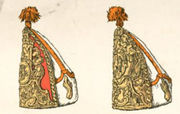
The mitre cap, whether in stiffened cloth or metal, became the distinguishing feature of the grenadier in the armies of Britain, Russia, Prussia and most German states during the 18th century. French grenadiers had other distinctions such as fringed epaulettes and dyed feathers in their tricorn hats. Austrian and Spanish grenadiers favoured high fur hats with long coloured cloth backs to them. The mitre was gradually replaced by bearskin hats in other armies and by 1914 it only survived in three regiments of the Prussian and Russian Imperial Guards. Russian grenadiers had worn their brass fronted mitre hats on active service until 1809 and some of these preserved for parade wear by the Pavlovski Guards until 1914 still had dents or holes from musket balls. Some have survived for display in modern museums and collections.
In addition to the mitre (later bearskin) headdress, grenadiers of the British Army were distinguished by flaming grenade insignia on belt-plates, pouches, coat-tails and collars plus shoulder wings. These distinctions disappeared when the "flank companies" (grenadiers and light infantry) of each regiment of line infantry were discontinued shortly after the Crimean War.
Bearskin cap
The cloth caps worn by the original grenadiers in European armies during the 17th century were frequently trimmed with fur. The practice fell into disuse until the second half of the eighteenth century when grenadiers in the British, Spanish and French armies began wearing high fur hats with cloth tops and, sometimes, ornamental front plates. The purpose appears to have been to add to the apparent height and impressive appearance of these troops both on the parade ground and the battlefield.[3]
During the nineteenth century, the expense of bearskin caps and difficulty of maintaining them in good condition on active service led to this form of headdress becoming generally limited to guardsmen, bands or other units having a ceremonial role. The British Foot Guards did however wear bearskins in battle during the Crimean War and on peacetime manoeuvers until the introduction of khaki service dress in 1902.[4]
Immediately prior to the outbreak of World War I in 1914, bearskins were still worn by guard or other units in the British, Belgian, Danish, Dutch, Russian and Swedish armies.[5]. This did not include use of the busby and other types of smaller fur headdress sometimes confused with the high bearskin. The Italian Sardinian Grenadiers had discarded bearskins in the nineteenth century but were to readopt them for limited ceremonial wear in modern times.
Firearms

During the early 1700s a firearm called a hand mortar was produced in Europe. This was a shoulder-fired weapon intended to launch a grenade at the enemy. However, little evidence exists showing that hand mortars were ever widely used in grenadier units.
Grenadier regiments
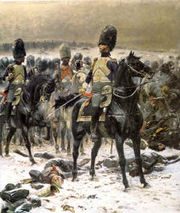
The term grenadier was retained or adopted by various elite infantry units, including Potsdam Grenadiers, the Foot Grenadiers, Fusilier-Grenadiers, Tirailleur-Grenadiers and Horse Grenadiers of Napoleon's Imperial Guard, the Imperial Russian Grenadier Leib Guards Regiment, Britain's Grenadier Guards and the 101st Grenadiers. The latter was part of the British Indian Army and claimed to be the first and oldest grenadier regiment (as opposed to grenadier companies) in the British Empire. During the American Revolution of 1775-1783, the Connecticut 1st Company Governor's Foot Guards [2] and the 11th Regiment of Connecticut Militia had grenadier companies. [3] [4]. New York City also had a Grenadier unit [5].
With the standardisation of training and tactics, the need for separate grenadier companies at regimental level had passed by the mid nineteenth century and the British, French and Austrian armies phased out these sub-units between 1850 and 1860. However as late as 1914 the Imperial German and Russian Armies included a number of grenadier regiments. In the Russian Army these comprised the Grenadier Guards Regiment as well as the Grenadier Corps of sixteen regiments. Five regiments of the Prussian Guard were designated as Garde-Grenadiers and there were an additional fourteen regiment of grenadiers amongst the line infantry of the German Empire. In both Russian and German armies the grenadier regiments were considered a historic elite, distinguished by distinctions such as plumed helmets in full dress or special braiding. Their role and training however no longer differed from that of the rest of the infantry.
Modern usage
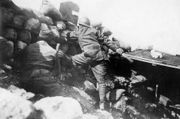
In modern times, regiments using the name grenadiers are effectively indistinguishable from other infantry, especially when hand grenades, RPGs, and other types of explosive arms have become standard-issue weaponry; however, such regiments retain at least the tradition of their elite past. Grenadier can also refer to soldiers utilizing grenade launchers, including those mounted on rifles. During World War I a proposal to designate specialist grenade launching units in the British Army as grenadiers was vetoed by the Grenadier Guards who considered that they now had exclusive rights to the ancient distinction, and the term Bomber was substituted.
During World War I, German troops referred to as pioneers, who were early combat engineers or sappers and stormtroopers began using two types of hand grenades in trench warfare operations against the French to clear opposing trenches of troops. The more effective of the two was the so called "potato masher" Stielhandgranate, which were Stick grenades[6].
The last known unit to serve as grenadiers, and employing grenades as their weapons, was a special "Grenadier brigade" formed by the Red Army within the 4th Army during the Tikhvin defensive operation in October 1941. It was a measure taken because of lack of firearms, and the commander of the brigade was appropriately General Major G.T. Timofeyev who had served in one of the the Russian Imperial Army's grenadier regiments during the First World War.[7]
In the Vietnam War U.S squads usually had at least one soldier whose role was that of a grenadier. He was usually armed with an M79 grenade launcher, although towards the end of the war it was replaced with an XM148 grenade launcher underslinging an M16 rifle in very small numbers. In infantry squads the grenadier was dedicated to his weapon, meaning that he usually carried only the M79 and a Colt 1911 side arm. In some cases, grenadiers were not even issued this sidearm. The M79 was designed to bridge the gap between the maximum throwing range of a grenade and the minimum distance of mortar fire. It also allowed the use of various rounds, notably High Explosive, buckshot, Flechette, smoke grenades and Parachute Flares. Modern US squads have continued the concept of the grenadier armed with an M203 grenade launcher or M320 attached to an M16 or M4.
Grenadiers today
Argentina
The Argentine Army, still maintains a prestigious unit known as the Horse Grenadiers Regiment (Regimiento de Granaderos a Caballo)--actually a battalion-strength formation—which serves as the Presidential ceremonial escort and guard unit. The Regiment's founder and first commanding officer was national hero General José de San Martín. Unlike most other units which carried the title of "grenadiers", the Argentine Grenadiers are a cavalry unit, and continue to mount horses for ceremonial purposes.
Belgium
The Belgian Army retains two regiments of grenadiers based in Brussels. First raised in 1837 from companies drawn from the line infantry of the newly independent Kingdom, these troops served with distinction in both World Wars. In peacetime they had a ceremonial role which corresponded to that of Royal Guards in other armies. In 1999 the historic blue and red full dress worn prior to World War I was reintroduced for limited wear, although the tall bearskin headdress is now made of synthetic material.
Canada
The Canadian Grenadier Guards is one of the longest serving units in the Canadian reserve, it still continues today, both in its reserve role and as a Ceremonial Guard at Rideau Hall among other places of symbolic importance.
Chile
The same case of the Mounted Grenadier Regiment in Argentina also applies to its western neighbor Chile. The 1st Armored Cavalry Regiment "Grenadiers" (Regimiento de Caballeria Blinada n.1 "Granaderos") of the Chilean Army is active since 1827, has fought in every major battle of the Chilean Army in the 19th century and since 1907 has served as the Escort Regiment to the President of Chile in every important national occasion. This regiment is named after General Manuel Bulnes Prieto, the founder of the regiment.
Germany
In the German Army Armoured Grenadier (Panzergrenadier) is the lowest rank in the Panzergrenadiere branch of service which translates into mechanized infantry.
Furthermore Grenadier is the lowest rank in the army part of the guard battaillon (Wachbattaillon).
India
The Grenadiers are a regiment of the Indian Army, formerly known as the 4th Bombay Grenadiers when part of the British Indian Army.
Italy
The 1st Grenadiers of Sardinia regiment (Reggimento Granatieri di Sardegna) is currently part of the Mechanized Infantry brigade with the same name in the Italian Army. This unit traces its history back to a Guards regiment raised in 1659 and is made up predominantly of one year volunteers. On ceremonial occasions the Italian Grenadiers parade in their nineteenth century blue uniforms and fur headdresses. The 1st Grenadiers of Sardinia regiment is currently (2010) the only infantry regiment of the Italian Army with two battalions (1st "Assietta" and 2nd "Cengio" Grenadiers battalions), and it is likely that in the near future its 2nd battalion will be detached to re-activate the 2nd Sardinia Grenadiers Regiment.
Mexico
In Mexico, Grenadiers (Granaderos) are heavily armed specialist police units used for anti-riot duties and other security roles.
Netherlands
The modern Dutch Army maintains a regiment of Guard Grenadiers who retain the bearskin headdress of the early nineteenth century. This regiment has been amalgamated with the Jager Guards to form the "Garderegiment Grenadiers en Jagers" Two of its companies are Jagers (Rifles), the other two are grenadiers; it wears the maroon beret and is an air assault and para trained unit.
Norway
In the Norwegian Army, grenadier (Norwegian: "Grenader") is used as a rank, the lowest enlisted below sergeant, to distinguish professional soldiers from conscripts. The grenadiers are employed for positions requiring more experience and/or professional presence. Fully professionalised units, such as the Telemark Battalion, serve as workhorses in international operations.
Switzerland
In the Swiss Army, the Grenadiers form the elite Special Forces. They are used for especially challenging operations and are initially trained in Isone, a secluded, mountainous region in the South of Switzerland. The Swiss Grenadiers specialize in urban warfare, guerrilla warfare, anti-terrorist operations, commando tactics, sniper missions, hand to hand combat, and other special operations.
UK
The Grenadier Guards are the most senior of the five prestigious regiments of foot guards, all of which retain the bearskin headdress originally associated with grenadiers.
References
- ↑ Rene Chartrand, page 18 Louis XIV's Army, ISBN 0-845045-850-1
- ↑ Stuart Reid, page 16 "British Redcoat 1740-93", ISBN 1 85532 554 3
- ↑ Military Uniforms of the World: Preben Kannil SBN 71370482 9
- ↑ British Military Uniforms From Contemporary Pictures: W.Y.Carman Hamlyn Publishing Group 1968
- ↑ "Uniforms of the World": Richard Knotel, ISBN 0-684-16304-7.
- ↑ p.36, Gudmundsson, Hyland
- ↑ Alexei Valeriyevich Isayev, Cauldrons of 41': History of the Great Patriotic War which we didn't know, Yauza, Moscow, 2005 (in Russian)[1]
Sources
- Gudmundsson, Bruce I., Hyland, William, Stormtroop Tactics: Innovation in the German Army, 1914-1918, Greenwood Publishing Group, Incorporated, 1995